Kunduz
Pashto: کندز | |
|---|---|
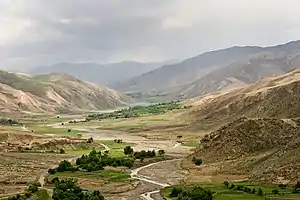 | |
 Kunduz Location in Afghanistan 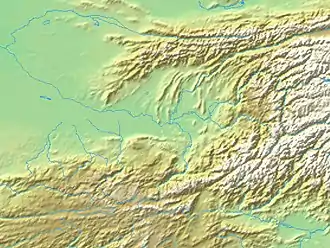 Kunduz Kunduz (Bactria)  Kunduz Kunduz (West and Central Asia) | |
| Coordinates: 36°43′43″N 68°52′5″E / 36.72861°N 68.86806°E | |
| Country | |
| Province | Kunduz Province |
| District | Kunduz District |
| First mention | 329 BCE |
| Area | |
| • Total | 11,206 ha (27,691 acres) |
| • Land | 112 km2 (43 sq mi) |
| Elevation | 351 m (1,152 ft) |
| Population (2014–2015)[2] | |
| • Total | 268,893 |
| • Density | 2,400/km2 (6,200/sq mi) |
| Population total is estimated | |
| Time zone | UTC+4:30 (Afghanistan Time) |
| Main language | |
| Climate | BSk |
Kunduz (/kʊnduːz/; Pashto: کندز; Persian: قندوز original name: کُهَندِژ) is a city in northern Afghanistan, the capital of Kunduz Province. The city has an estimated population of about 268,893 as of 2015, making it about the 7th-largest city of Afghanistan, and the largest city in northeastern Afghanistan.[2] Kunduz is in the historical Tokharistan region of Bactria, near the confluence of the Kunduz River with the Khanabad River. Kunduz is linked by highways with Kabul to the south, Mazar-i-Sharif to the west, and Badakhshan to the east. Kunduz is also linked with Dushanbe in Tajikistan to the north, via the Afghan dry port of Sherkhan Bandar. This city is famous in Afghanistan for its watermelon production.
As of 2015, the land use of the city (within the municipal boundary) is largely agricultural (65.8% of total area). Residential land comprises nearly half of the 'built-up' land area (48.3%) with 29,877 dwellings. Institutional land comprises 17.9% of built-up land use, given that the airport is within the municipal boundary.[1]
Etymology
Kunduz is also sometimes spelled (romanized) as Kundûz, Qonduz, Qondûz, Konduz, Kondûz, Kondoz, or Qhunduz. The name of the city is derived from the Persian compound, kohan dež, "old/ancient fort".[3]
History
Kunduz is the site of the ancient city of Drapsaka. It was a great centre of Buddhist learning and very prosperous during the 3rd century AD.
The city used to be called Aornos (Bactrian: οαρνο, romanized: warn)[4] and later Walwalij[5] or Varvaliz, a compound of the old name Warn and Bactrian: λιζο, romanized: liz, lit. 'fortress'.[6] The name Kuhandiz began to be used from the Timurid time.
The Qonduz Khanate, also known as the Khanate of Kunduz, was a historical Central Asian state that existed during the late medieval and early modern periods. Situated in the region that is present-day northern Afghanistan,[7] the Qonduz Khanate played a significant role in the socio-political landscape of the time. Its emergence, development, and ultimate decline shaped the history of the region and left a lasting impact on the cultures and societies of Central Asia.[8][9]
In the 18th and 19th centuries it was the capital of an Uzbek khanate which reached its largest extent, from Balkh to the Pamir Mountains, during the reign of Murad Beg (1815–1842). Murad Beg faced the decline of his state after being defeated by Dost Mohammad Khan in the Afghan Turkestan Campaign of 1838-39. After Murad's death, the khanate declined and was eventually subjugated by Afghanistan in 1859. It was part of The Great Game between the British and Russians.
In the early 20th century, between one-hundred and two-hundred thousand Tajiks and Uzbeks fled the conquest of their homeland by the Russian Red Army and settled in northern Afghanistan.[10]
In the early 20th century, under the governance of Sher Khan Nashir, Kunduz became one of the wealthiest Afghan provinces. This was mainly due to Nasher's founding of the Spinzar Cotton Company, which continues to exist in post-war Afghanistan. At its peak, the Spinzar Cotton Company employed 5,000 people full time. Kunduz is the most important agricultural province which produces wheat, rice, millet, and other products and obtained the nickname of "the hive of the country."[11]
21st century
Kunduz is the centre for the northeast provinces and was captured by the Taliban in 1997. It was the last major city held by the Taliban before its fall to US-backed Afghan Northern Alliance forces on 26 November 2001.
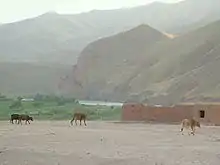
During the summer of 2015, the Taliban advanced and attacked the city, which resulted in a battle for control of the city against Afghan forces. Tens of thousands of inhabitants were displaced internally by the fighting.[12][13][14] On 28 September 2015 the Taliban flag was again raised in the city center and the Taliban managed to capture the city prison and free many prisoners.[15][16] On 3 October 2015, a United States Air Force AC-130U gunship attacked the Kunduz Trauma Centre operated by Médecins Sans Frontières (MSF, or Doctors Without Borders). The Afghan Armed Forces counter-attacked and managed to re-capture the city in 15 days. The Taliban announced that, after achieving their objectives, they have withdrawn from the city's center. Zabiullah Mujahid, a Taliban spokesperson, said that their main object in leaving the city is to avoid civilian casualties from air raids.[17] In April 2018 the Afghan Air Force conducted an airstrike that killed and injured dozens of civilians at a religious school in Kunduz.[18] On 31 August 2019, the Taliban forces launched another attack on the city, setting off a major battle with local security forces.
| History of Afghanistan |
|---|
 |
| Timeline |
|
On 19 May 2020, the Taliban killed one policeman and one civilian and injured 18 others in a motorbike bomb blast in Kunduz. On the same day, the Taliban attempted again to capture Kunduz, attacking several government posts but were repelled by the Afghan security forces. The Taliban were forced to flee the city, leaving ten dead bodies behind.[19] Eight Afghan soldiers and three civilians were killed and 55 others were wounded during the Taliban attack.[20]
On 8 August 2021, the Taliban as part of their nationwide military offensive captured Kunduz, along with Sar-e-Pul and Taloqan after heavy clashes with ANA forces.[21][22]
On 8 October 2021, a militant of ISKP detonated a suicide vest targeting shia worshippers at the Gozar-e-Sayed Abad Mosque, killing 50+ people and wounding over 100.
Geography
Kunduz is strategically situated on the main north–south highway linking Kabul to Tajikistan, and east–west Mazar-i-Sharif to Taloqan and Fayzabad.
Climate
Kunduz has a cold semi-arid climate (Köppen climate classification BSk) with hot summers and cool winters. Precipitation is generally low except from January to April, with summers almost always rainless.
| Climate data for Kunduz | |||||||||||||
|---|---|---|---|---|---|---|---|---|---|---|---|---|---|
| Month | Jan | Feb | Mar | Apr | May | Jun | Jul | Aug | Sep | Oct | Nov | Dec | Year |
| Record high °C (°F) | 21.2 (70.2) |
25.0 (77.0) |
32.8 (91.0) |
38.9 (102.0) |
42.2 (108.0) |
46.2 (115.2) |
45.3 (113.5) |
44.2 (111.6) |
39.2 (102.6) |
39.4 (102.9) |
28.4 (83.1) |
21.6 (70.9) |
46.2 (115.2) |
| Mean daily maximum °C (°F) | 6.3 (43.3) |
9.5 (49.1) |
15.8 (60.4) |
23.0 (73.4) |
29.8 (85.6) |
37.3 (99.1) |
39.0 (102.2) |
36.9 (98.4) |
31.8 (89.2) |
24.5 (76.1) |
16.0 (60.8) |
9.7 (49.5) |
23.3 (73.9) |
| Daily mean °C (°F) | 1.6 (34.9) |
4.4 (39.9) |
10.4 (50.7) |
17.2 (63.0) |
22.9 (73.2) |
29.3 (84.7) |
31.3 (88.3) |
29.2 (84.6) |
23.9 (75.0) |
16.9 (62.4) |
9.5 (49.1) |
4.4 (39.9) |
16.8 (62.1) |
| Mean daily minimum °C (°F) | −2.4 (27.7) |
0.0 (32.0) |
5.7 (42.3) |
11.6 (52.9) |
15.7 (60.3) |
20.9 (69.6) |
23.3 (73.9) |
21.5 (70.7) |
16.3 (61.3) |
10.6 (51.1) |
4.1 (39.4) |
0.0 (32.0) |
10.6 (51.1) |
| Record low °C (°F) | −22.7 (−8.9) |
−23.1 (−9.6) |
−11.8 (10.8) |
−2.1 (28.2) |
4.2 (39.6) |
12.5 (54.5) |
15.7 (60.3) |
12.6 (54.7) |
3.5 (38.3) |
−2.0 (28.4) |
−9.8 (14.4) |
−20 (−4) |
−23.1 (−9.6) |
| Average precipitation mm (inches) | 44.0 (1.73) |
56.5 (2.22) |
76.7 (3.02) |
54.4 (2.14) |
29.8 (1.17) |
0.1 (0.00) |
1.3 (0.05) |
0.3 (0.01) |
0.1 (0.00) |
7.3 (0.29) |
23.7 (0.93) |
28.4 (1.12) |
322.6 (12.68) |
| Average rainy days | 5 | 6 | 11 | 10 | 9 | 1 | 1 | 0 | 0 | 3 | 5 | 6 | 57 |
| Average snowy days | 5 | 4 | 2 | 0 | 0 | 0 | 0 | 0 | 0 | 0 | 1 | 2 | 14 |
| Average relative humidity (%) | 80 | 75 | 75 | 71 | 54 | 31 | 28 | 29 | 32 | 44 | 63 | 76 | 55 |
| Mean monthly sunshine hours | 114.4 | 114.6 | 158.9 | 201.0 | 276.5 | 332.1 | 340.2 | 315.5 | 289.7 | 221.8 | 169.3 | 118.3 | 2,652.3 |
| Source: NOAA (1958-1983)[23] | |||||||||||||
Demographics

The city of Kunduz has an estimated population of about 268,893 as of 2015.[2] Ethnic Pashtuns comprise the largest segment, followed by Uzbeks, Tajiks, Arabs and a few others.[10][24][25] Kunduz is the capital of a highly diverse province that includes significant populations of Pashtuns, Tajiks, Uzbeks, Hazaras, Arabs, Balochis and Turkmens.[26]
Kunduz Arabs speak Persian and Pashto, Afghanistan's two official languages, rather than Arabic. However, they claim a strong Arab identity, based on their tribal origins in Arabia. This may in fact point to the seventh-century and eighth-century migration to this and other Central Asian locales of many Arab tribes from Arabia in the wake of the Islamic conquests of the region.[27]
Administration
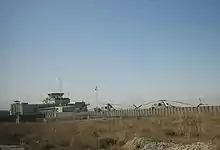
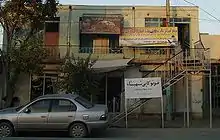
Kunduz city is divided into 8 Districts ('Nahias') with a total land area of 11,206 hectares.[1]
The most influential leader of Kunduz was Arif Khan, who was a governor of Kunduz Province and was shot dead in the city of Peshawar, Pakistan in the year 2000. Soon after the incident his brother Haji Omar Khan took his responsibility and was appointed as the Governor of Kunduz (2000–01).
Sports
- Professional sports teams from Kunduz
| Club | League | Sport | Venue | Established |
|---|---|---|---|---|
| Pamir Zalmi | Shpageeza Cricket League | Cricket | Kunduz Cricket Ground | 2021 |
| Mawjhai Amu F.C. | Afghan Premier League | Football | Kunduz Ground | 2012 |
Stadiums
- Kunduz Cricket Ground
- Kunduz Ground
Notable people
- Sher Khan Nasher, chief clan of (Ghilji) Kharoti Nasher tribe
- Gholam Nabi Nasher Khan (1926–2010), parliamentarian
- Sayed Noorullah Murad (Afghan politician, member of federal cabinet, military commander and scholar) Imam Saheb district
- Gulbudin Hekmatyar, Afghan political leader, Afghan politician, former mujahideen and drug trafficker
- Javed Ahmadi (1992–), player of the Afghanistan national cricket team
- Abdul Rauf Ibrahimi, former Afghan National Parliament Speaker
- Farhad Darya, Afghan singer
See also
References
- 1 2 3 4 "State of Afghan Cities report 2015 (Volume-II)" (in English and Dari). UN-Habitat. 2015. Archived from the original on 26 October 2021. Retrieved 26 October 2021.
- 1 2 3 "State of Afghan Cities report 2015 (Volume-I English)". UN-Habitat. 2015. Archived from the original on 26 October 2021. Retrieved 26 October 2021.
- ↑ Branch, India Army General Staff (1972). Historical and Political Gazetteer of Afghanistan. Akadem. Druck- u. Verlagsanst. ISBN 9783201012720.
- ↑ Sims-Williams. New Light on Ancient Afghanistan. pp. 16–17.
- ↑ "Asien-Afrika-Institut". uni-hamburg.de. Archived from the original on 9 May 2012.
- ↑ Gholami, Saloumeh. Selected Features of Bactrian Grammar. p. 80.
- ↑ "WHKMLA : History of Kunduz". www.zum.de. Retrieved 15 August 2023.
- ↑ Burnes, Sir Alexander (1839). Reports and Papers, Political, Geographical, & Commercial Submitted to Government by Alexander Burnes, Lieutenant Leech, Doctor Lord, and Lieutenant Wood, Employed on Missions in the Years 1835-36-37 in Scinde, Affghanisthan, and Adjacent Countries. G.H. Huttmann, Bengal Military Orphan Press.
- ↑ Burnes, Sir Alexander (1839). Travels Into Bokhara: Containing the Narrative of a Voyage on the Indus from the Sea to Lahore, with Presents from the King of Great Britain, and an Account of a Journey from India to Cabool, Tartary, and Persia : Performed by Order of the Supreme Government of India. John Murray.
- 1 2 Wörmer, Nils (2012). "The Networks of Kunduz: A History of Conflict and Their Actors, from 1992 to 2001" (PDF). Stiftung Wissenschaft und Politik. Afghanistan Analysts Network. p. 8. Retrieved 12 January 2014.
- ↑ "Afghanistan's Misguided Economy | Boston Review". 8 February 2014. Archived from the original on 8 February 2014. Retrieved 9 January 2023.
- ↑ "Afghans counter Taliban offensive in northern Kunduz province". BBC News.
- ↑ "Taliban and Afghan Government Dispute Status of Kunduz". New York Times. 21 June 2015.
- ↑ "Afghanistan: Taliban advance on key northern city". The Sydney Morning Herald.
- ↑ "Taliban 'seize half' of Afghanistan's Kunduz city". www.bbc.com. BBC. 28 September 2015. Retrieved 28 September 2015.
- ↑ "Afghan Taliban seize northern city center in major attack". Reuters. 28 September 2015. Retrieved 28 September 2015.
- ↑ "Taliban admit Kunduz withdrawal". 13 October 2015. Retrieved 8 April 2018 – via www.bbc.com.
- ↑ cbs/AFP (3 April 2018). "Carnage as airstrike hits boy's[sic] school in Taliban territory". CBS News. Retrieved 13 April 2018.
- ↑ "Motorbike bomb, fighting claim 12 lives in Afghanistan's Kunduz province". 19 May 2020. Archived from the original on 20 May 2020 – via http://www.xinhuanet.com/.
{{cite web}}: External link in|via= - ↑ "Eight Afghan soldiers die fighting off Taliban attack on key city". 19 May 2020. Archived from the original on 12 April 2021. Retrieved 28 May 2020 – via au.news.yahoo.com/.
- ↑ Gibbons-Neff, Thomas. "The Taliban seize Kunduz, a major city in northern Afghanistan". The New York Times. Retrieved 8 August 2021.
- ↑ Latifi, Ali. "Taliban captures Kunduz, third provincial capital in three days". Al Jazeera. Retrieved 8 August 2021.
- ↑ "Kunduz Climate Normals 1958-1983". National Oceanic and Atmospheric Administration. Retrieved 25 December 2012.
- ↑ "Kunduz Province" (PDF). Program for Culture & Conflict Studies. Naval Postgraduate School. Archived from the original (PDF) on 2 October 2012. Retrieved 12 January 2014.
- ↑ "2003 National Geographic Population Map" (PDF). Thomas Gouttierre, Center For Afghanistan Studies, University of Nebraska at Omaha; Matthew S. Baker, Stratfor. National Geographic Society. 2003. Archived from the original (PDF) on 27 February 2008. Retrieved 18 June 2017.
- ↑ Bleuer, Christian (1 January 2012). "State-building, migration and economic development on the frontiers of northern Afghanistan and southern Tajikistan". Journal of Eurasian Studies. 3 (1): 69–79. doi:10.1016/j.euras.2011.10.008.
- ↑ Barfield, T.J. (1981), The Central Asian Arabs of Afghanistan: Pastoral Nomadism in Transition, University of Texas Press, ISBN 9780292710665
Further reading
- Dupree, Nancy Hatch (1977): An Historical Guide to Afghanistan. 1st Edition: 1970. 2nd Edition. Revised and Enlarged. Afghan Tourist Organization.
- Thomas J. Barfield, The Central Asian Arabs of Afghanistan: Pastoral Nomadism in Transition. 1982.
External links
- Kunduz Province by Naval Postgraduate School
- Welcome to Kunduz, Allauddin
- . Encyclopædia Britannica (11th ed.). 1911.
